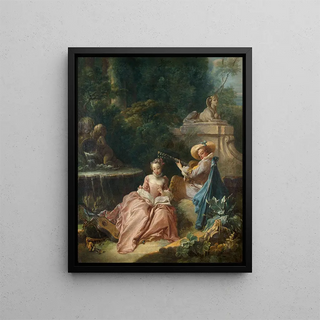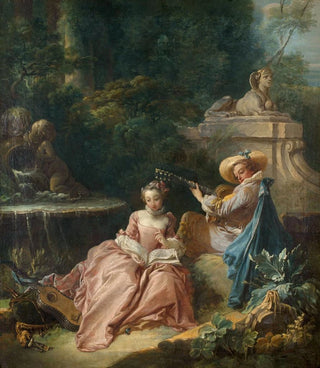Painting The Music Lesson - François Boucher | Art print Source: Tableau La Leçon de musique - François Boucher | Reproduction


View from behind

Frame (optional)
In the vast panorama of Rococo art, "The Music Lesson" by François Boucher stands out as an iconic work, capturing the very essence of this artistic period. This painting, which evokes the lightness and elegance of the 18th century, transports the viewer into a universe where music and beauty meet. The scene, bathed in soft, warm light, depicts a moment of sharing and pleasure, where music becomes the guiding thread of a delicate interaction between the characters. The intimate atmosphere of this artwork invites contemplation, allowing one to immerse themselves in a world where every detail is carefully orchestrated to evoke emotion.
Style and uniqueness of the work
Boucher's style is characterized by an exceptional mastery of colors and forms. In "The Music Lesson," he uses a luminous palette, where pastel shades blend harmoniously to create an airy ambiance. The characters, depicted with delicate grace, are enveloped in sumptuous draperies that highlight their elegance. The composition is carefully balanced, with each element arranged to direct the viewer's gaze toward the center of the work, where the main action unfolds. Music, omnipresent, seems almost tangible, and the expressions of the characters reflect shared joy, a complicity that transcends time. This painting perfectly illustrates Boucher's ability to capture moments of life, while sublimating them through a rich and evocative visual language.
The artist and his influence
François Boucher, a major figure of French Rococo, knew how to mark his era with his flamboyant style and unique artistic vision. Born in 1703, he was influenced by the masters of Italian painting and developed a distinctive language, combining sensuality and lightness. Boucher was one of the most prominent artists at the court of Louis XV, and his work profoundly influenced the taste of his time. His ability to represent beauty in all its forms, whether human or natural, made him a pioneer in 18th-century art. "The Music Lesson" perfectly illustrates this influence, combining

Matte finish

View from behind

Frame (optional)
In the vast panorama of Rococo art, "The Music Lesson" by François Boucher stands out as an iconic work, capturing the very essence of this artistic period. This painting, which evokes the lightness and elegance of the 18th century, transports the viewer into a universe where music and beauty meet. The scene, bathed in soft, warm light, depicts a moment of sharing and pleasure, where music becomes the guiding thread of a delicate interaction between the characters. The intimate atmosphere of this artwork invites contemplation, allowing one to immerse themselves in a world where every detail is carefully orchestrated to evoke emotion.
Style and uniqueness of the work
Boucher's style is characterized by an exceptional mastery of colors and forms. In "The Music Lesson," he uses a luminous palette, where pastel shades blend harmoniously to create an airy ambiance. The characters, depicted with delicate grace, are enveloped in sumptuous draperies that highlight their elegance. The composition is carefully balanced, with each element arranged to direct the viewer's gaze toward the center of the work, where the main action unfolds. Music, omnipresent, seems almost tangible, and the expressions of the characters reflect shared joy, a complicity that transcends time. This painting perfectly illustrates Boucher's ability to capture moments of life, while sublimating them through a rich and evocative visual language.
The artist and his influence
François Boucher, a major figure of French Rococo, knew how to mark his era with his flamboyant style and unique artistic vision. Born in 1703, he was influenced by the masters of Italian painting and developed a distinctive language, combining sensuality and lightness. Boucher was one of the most prominent artists at the court of Louis XV, and his work profoundly influenced the taste of his time. His ability to represent beauty in all its forms, whether human or natural, made him a pioneer in 18th-century art. "The Music Lesson" perfectly illustrates this influence, combining
12,34 €






